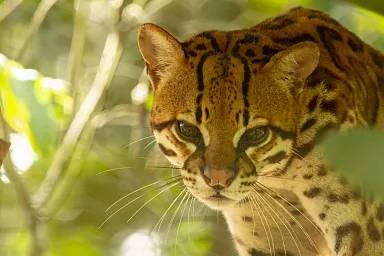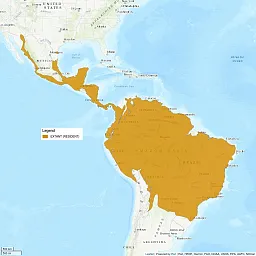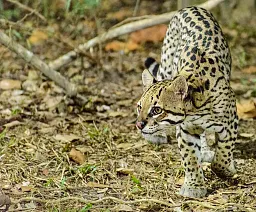
Ocelot photo © Andrés León-Reyes · some rights reserved
Ocelot
Species Facts
Demand for its pelt, with its beautiful dappled markings, has made the ocelot one of the most heavily exploited species of small cats.
- Scientific Designation: Leopardus pardalis
- Endangered Status: Least Concern (LC)
- Lifespan: 7-10 years (in the wild)
- Weight: 8-12 kg
- Body Length: 55-100 cm
- Tail Length: 30-45 cm
Appearance
Its fur is short and sleek, lying close to the body. The background color can be cream to tawny yellow, reddish gray, or grey. The background coat is marked with solid or open-centered dark spots that sometimes run in lines across the body. The neck and belly are white.
Weighing 8-10 kg, and roughly the size of a bobcat, the ocelot is classified as a medium-sized cat. It has rounded ears and a relatively short tail ringed with black or with black bars on the upper surface.

Ocelot photo © rancholaspalomas · some rights reserved
Diet
The ocelot is highly dependent on cover dense enough to harbor large rodent populations. Hunting primarily at night, the ocelot mostly hunts on the ground, preying on rodents, rabbits, birds, fish, reptiles, and insects. Most of its prey is terrestrial and nocturnal. However, its prey changes with the seasons as the numbers of the various prey species fluctuate.

Species Distribution
This cat was historically found from as far north as Arkansas and Arizona in North America to as far south as northern Argentina in South America. Currently, the ocelot is distributed from southern Texas and the coastal lowlands of Mexico, through Central America, to northern Argentina.
This cat lives in a broad range of tropical and subtropical habitats with elevations ranging from sea level to 1200 meters.
Distribution map courtesy of IUCN (International Union for Conservation of Nature), compiled in 2015 by Arturo Caso, Paula Cruz, Carlos De Angelo, Yamil Di Blanco, Carlos Lopez Gonzalez, Agustin Paviolo, and Veronica Quiroga.

Ocelot photo © Allan Hopkins · some rights reserved
Threats to the Ocelot
The population estimate in North America (Southern Texas) is 80 to 120 individuals. There are no population estimates available from other parts of its range, but the consensus is that the number of ocelots has declined through hunting by humans and habitat loss. Habitat loss is most likely replacing hunting as the major threat.
This solitary cat is classified under Least Concern (LC) by the International Union for Conservation of Nature (IUCN) and is listed in appendix I of the Convention on International Trade in Endangered Species (CITES).
Want to help us research and conserve this species?
Felidae Conservation Fund helps researchers around the world study and protect felids of all sizes.
Make sure you write a comment with "Ocelot" so we can designate 100% of your donation to go to protecting this species.
Do You Have 2-4 Hours A Month To Preserve Your Local Ecosystem?
Our volunteers are the driving force behind making true change in ecosystem health and wild cat conservation. Some like to volunteer in the field, others help us maintain our online presence, and some work with events. With just a few hours a month, you can make a difference, too.
Make A Difference Right Now
As a 501(c)3 nonprofit, our work is only possible because of generous donors like you.
More than 90% of your donation will go directly to our groundbreaking research, outreach, and education programs.
This is where true change starts. If you’d like to be a part of it, make a donation to Felidae Conservation Fund today:
Or,
